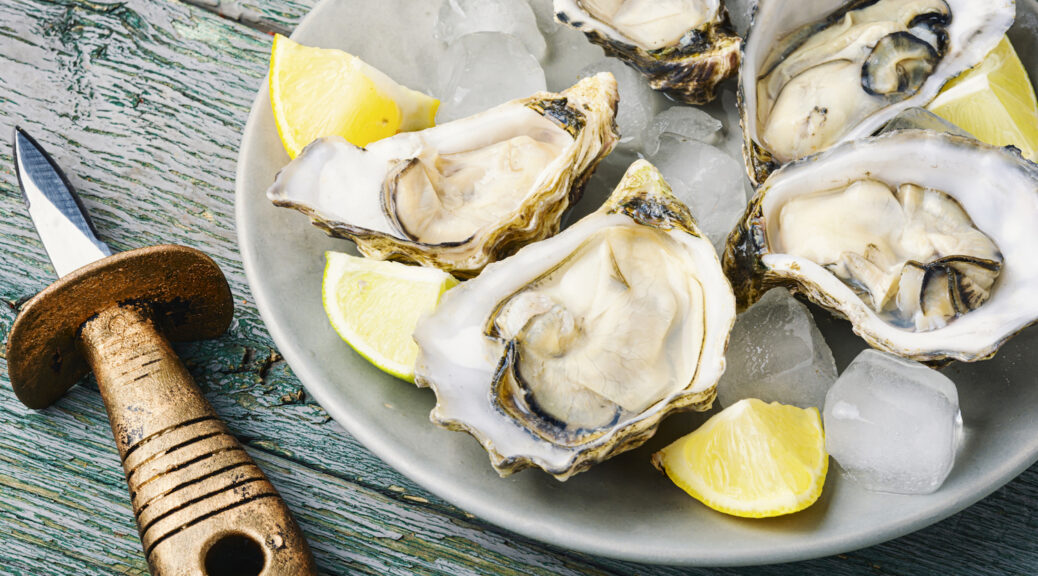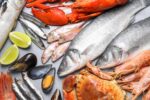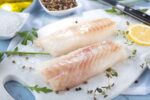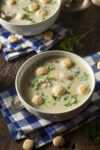
Ways to Prepare and Cook Oysters
Oysters were plentiful along the U.S. east coast during the 1800s, and were cheap enough for the working class to buy.
Over time, though, the demand for oysters depleted many of the beds. Their scarcity caused prices to rise and oysters became an expensive delicacy.
INFORMATION BELOW FROM 1800s COOKBOOKS
Oysters must be fresh and fat to be good and are in season from September to May. They are sometimes eaten during the summer months, but are not so palatable and are more apt to be contaminated by the bacteria of warm water.
The bluish green color of some oysters is due to the oyster’s feeding upon vegetable materials and does not harm the flavor of the oyster. The small ones, such as are sold by the quart, are good for pies, fritters, or stews. The largest of this sort are nice for frying or pickling for family use.
Since oysters spoil readily, they must be kept cold during transportation. They are now shipped in containers surrounded by ice. Formerly ice was placed in contact with the oysters.
CLEANING OYSTERS
Drain off the liquor and if it is to be used, strain it through a fine strainer. Place the oysters in a strainer or colander, and wash them. Do not allow oysters to stand in water after washing. Run each oyster through the fingers to remove pieces of shell that may be clinging to it.
TO KEEP OYSTERS
Put them in a tub and cover them with salt and water. Let them remain for twelve hours. Then they are to be taken out and allowed to stand for another twelve hours without water. If left without water every alternate twelve hours, they will be much better than if constantly kept in it. Never put the same water twice to them.
FRIED OYSTERS
Choose two dozen large oysters, and drain thoroughly in a colander, then dry in a towel. Dip first in sifted cracker-crumbs, then in one egg beaten with a tablespoon of cold water, half a teaspoon of salt, and a saltspoon* of pepper. Roll again in crumbs and drop into boiling lard. If a wire frying-basket is used, lay them in this. Fry to a light brown. Lay them on brown paper a moment to drain, and serve at once on a hot platter. As they require hardly more than a minute to cook, it is better to wait till all are at the table before beginning to fry. Oysters are very good merely fried in a little hot butter; but the first method preserves their flavor best.
*saltspoon – a miniature spoon used with an open salt cellar for individual use before table salt was free-flowing. One saltspoon equals one-fourth teaspoon.
BAKED OYSTERS
Put into a baking-dish one-half cup butter and one cup cream. Heat thoroughly but do not boil. Add three tablespoons sherry, one teaspoon anchovy paste, a dash of red pepper, and a grating of lemon-peel. Dip out one-half cup of the mixture and set aside. Put one quart of oysters into a baking-dish, sprinkle with salt, pepper, grated cheese, and dried bread-crumbs. Pour over carefully the remaining mixture, sprinkle again with crumbs and cheese, and bake in a very hot oven. Serve immediately. If preferred, oysters may be baked this way in individual dishes.
CURRIED OYSTERS
Put into a saucepan one tablespoon butter and one teaspoon chopped onion. Fry the onion brown, then add one tablespoon flour and one teaspoon curry powder. Cook and stir until the mixture leaves the sides of the pan. Add one cup cream, and salt and pepper to season. Stir constantly until the sauce is thick. Add one quart of oysters with their liquor, and cook slowly until the edges of the oysters curl. Serve on toast.
OYSTERS IN BROWN SAUCE
Parboil a pint of oysters in their own liquor, skim out, and drain. Put into a saucepan one fourth cup butter, and cook until brown. Add one-fourth cup flour, and cook and stir until the mixture leaves the sides of the pan. Add one-half cup milk, one cup oyster liquor, one teaspoon anchovy paste, and salt and pepper to season. Cook until thick, add the oysters, reheat, and serve.
OYSTER COCKTAIL
Put into a glass two teaspoons lemon-juice, two drops of tabasco sauce, half a teaspoon of Worcestershire, two teaspoons tomato catsup, a pinch of salt, and a saltspoon of paprika. Mix thoroughly and add five or six small fresh oysters. Let stand for five minutes, and serve very cold.
RAW OYSTERS
When oysters are transported some distance, it is well to boil the liquor from which they have been taken and pour over them. This makes them plump and prevents them from being slimy. Take each oyster separately on a fork and drain from the liquor. Place them on the table in an oyster tureen or salad bowl. Have nearby a pile of small oblong dishes, scraped horseradish, pepper sauce, Worcestershire sauce, etc., so that after being helped, each guest may season to taste.
OYSTER STEW
Drain one quart of oysters and put the liquor to heat in a saucepan. Add one cup cream, and salt and red pepper to taste. Bring to the boil, add two tablespoons butter, and thicken with one teaspoon flour rubbed smooth in a little cold milk. Cook and stir until it thickens. Add the oysters, simmer until the edges curl and take from the fire. Add the juice of half a lemon, and pour over thin slices of the buttered toast.
OYSTER SOUP
Three pints of large fresh oysters.
Two tablespoonfuls of butter, rolled in flour.
A bunch of sweet herbs.
A saucer full of chopped celery.
A quart of rich milk.
Pepper.
Take the liquor of three pints of oysters. Strain it, and set it on the fire. Add pepper to your taste, two tablespoonfuls of butter rolled in flour, a bunch of sweet marjoram and other pot-herbs, with a saucer full of chopped celery. When it boils, add a quart of rich milk and as soon as it boils again, take out the herbs and put in the oysters just before you send it to table. Boiling them in the soup will shrivel them and destroy their taste.
SPICED OYSTERS
Two hundred large fresh oysters.
Four tablespoons strong vinegar.
A nutmeg, grated.
Three dozen cloves, whole.
Eight blades of mace, whole.
Two teaspoons salt.
Two teaspoons whole allspice.
As much cayenne pepper as will lie on the point of a knife.
Put the oysters, with their liquor, into a large earthen pitcher. Add to them the vinegar and all the other ingredients. Stir all well together. Set them in the stove or over a slow fire, keeping them covered. Take them off the fire several times, and stir them to the bottom. As soon as they boil completely, they are sufficiently done; if they boil too long they will be hard.
Pour them directly out of the pitcher into a pan, and set them away to cool. They must not be eaten till quite cold, or indeed till next day.
If you wish to keep them a week, put a smaller quantity of spice, or they will taste too much of it by setting so long. Let them be well covered.
PICKLED OYSTERS
Four hundred large fresh oysters.
A pint of vinegar.
Eight spoons of salt.
A pint of white wine.
Six tablespoons of whole black pepper.
Eight blades of mace.
Strain the liquor of the oysters and boil it. Then pour it hot over the oysters, and let them lie in it about ten minutes. Then take them out and cover them. Boil the liquor with the salt, pepper, mace, vinegar and wine. When cold, put the oysters in a close jar, and pour the liquor over them. Cover the jar very tight, and the oysters will keep a long time.
Image from Deposit Photos
=================================================
Do You Like Oysters? Leave a Comment Below.
=================================================




9 thoughts on “Ways to Prepare and Cook Oysters”
I have an old family recipe book from 1875. One recipe is for Oyster. The following word may be Kromshies. I would be grateful for any help with this.
I looked through various oyster recipes and couldn’t find any with a second word similar to what you mentioned. Does your recipe book mention this name, but then the recipe is missing?
I had one raw oyster and was the only one of about ten of us who ate them to get food poisoning. That was the end of oysters for me even though I like it better than I expected to before it made me sick. Enjoyed reading about this history. I read about many oyster suppers in the 1880s newspapers.
Yes, oyster recipes were sure in a lot of old cookbooks, too. They’re not so popular now that they are rather expensive.
I love Oysters, I can eat them raw! I see many recipes I have never tried, I think I will!
Eating raw oysters is popular, but I don’t believe I’ll try it. Hope you enjoy the recipes. I’d love to hear which ones you liked best.
Love oysters thanks for all the different ways to cook them.
I’m not a fan of seafood and no matter how cheap and plentiful oysters were in the past or may become in the future I simply couldn’t eat one! 🙂
I like boiled or steamed shrimp, crab and lobster, and have also eaten fried shrimp and clams. I’ve never tried oysters and probably won’t.